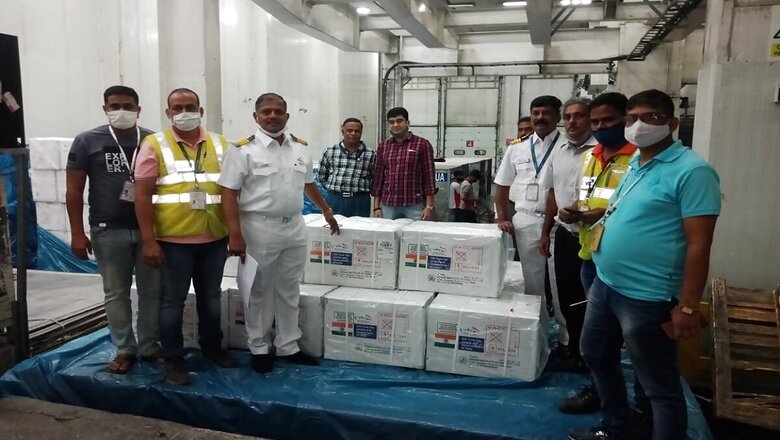
views
A culture of interdependence resulting from rising incidences of health crises is one of the striking features of globalisation. Health conditions beyond territorial boundaries can have a defining effect on individual countries’ public health and may even pose a grave risk to the economy. For many years, decision-makers around the world have treated health issues as secondary concerns in foreign policy, primarily due to the lack of awareness about the interconnectedness between health and areas of politics. Historically, health has been categorised as ‘low politics,’ occupying the lower echelons in national priority.
But developments in recent decades revealed a new context and reality for foreign policymakers and practitioners. Health issues have graduated to a mainstream foreign policy priority and emerged as an effective soft power tool for states to pursue their economic interests and international relations. For example, by the mid-1990s, the HIV/AIDS epidemic posed a formidable challenge for public health communities and to leaders around the world. The Bill Clinton administration not only increased the US’s overseas funding for HIV/AIDS-related work but also shifted its foreign policy to focus more on infectious diseases. Given the growing economic and social costs of the epidemic in the developing world, the World Bank and other international agencies also opened up new lending programmes and expanded their resource commitments to health-related developmental projects.
Although the term ‘health diplomacy’ has gained traction in recent decades, especially with the onset of globalisation, the practice can be traced back to the mid-nineteenth century. Between 1851 and 1894, medical administrators and scientists from different European countries gathered to discuss cholera, plague and yellow fever at a series of international sanitary conferences. These conferences provided a key platform for states to collaboratively develop new medical thinking on dealing with epidemics. When Europe was hit by a cholera outbreak in the early nineteenth century, countries struggled to implement national policies, especially the quarantine system. Despite the transnational character of the disease, it continued to be handled on a local community basis, as infectious diseases had been managed since medieval times. In the absence of international cooperation on transboundary diseases, many Europeans debated the effectiveness of preventive strategies imposed by the national governments. Preventing the spread and diffusion of transmissible diseases was the primary focus at the international sanitary conferences, and it was only after these conferences that countries worked towards creating an international health agency, which led to the establishment of the World Health Organisation (WHO) in 1948.
Health and Foreign Policy: The Changing Context
Health diplomacy was practiced long before the establishment of the formal institutions that are part of modern foreign policy and diplomacy. Health diplomacy is a multi-level and multi-actor interaction that shapes global health governance. Nation states remain central to health diplomacy, especially in building cooperation with various stakeholders — state, non-state and multilateral actors, non-governmental organisations, private-sector companies and the public. As health diplomacy varies from country to country, it provides a useful window into a country’s approach to international health institutions, guidelines and agreements, as well as their response to regional and global health challenges. Health diplomacy, therefore, acts as a bridge between the domestic and the global, as it binds national and bilateral commitments to multilateral partners.
The practice of health diplomacy, however, faces three paradoxes. Health issues have a technical and scientific core, which makes it a sole concern of domain experts, who not only distance themselves from politics but also the diplomatic community. As a result, the political visibility of health in certain countries remains low as does political will, ultimately reflecting in the low resource allocations for public health. However, increasingly, the determinants of health and the means to deal with health issues are moving beyond the control of healthcare professionals and require the involvement of a cross-section of policymakers, including diplomats, politicians, businessmen, civil society activists and private players.
The second paradox is that states still consider health issues as a fundamental national responsibility — despite their transnational character — and approach health-related challenges within nationalist frameworks. What they fail to realise is that health is a shared social objective that necessitates global partnerships.
Finally, the dissonance between international health agencies has widened with the increasing popularity of health issues on the global agenda. The collection of multilateral entities and bilateral agencies responsible for improving the health of the global population suffer from coordination issues and have failed to establish relationships conducive to collective action.
Health also involves critical economic dimensions related to international trade. The first two international sanitary conferences (in 1851 and 1859) put commerce at the heart of discussions, with policymakers deliberating on treaties to protect cross-border trade amid health threats. With the liberalisation of trade regulations, health has emerged as an arena of commercial interests of both governmental and non-governmental entities. Increasing collaboration can be seen between health and trade ministers within and among several countries.
For instance, At the 5th ASEAN [Association of Southeast Asian Nations] Health Ministers Meeting in 2000, senior health officials reiterated the need to strengthen the national and collective ASEAN capacity on issues of “health implications of globalisation and trade liberalisation” to promote inter-agency coordination and policy coherence and curtail competitiveness between countries. The adoption of the Sustainable Development Goals (SDGs) have further strengthened these linkages and highlighted the centrality of health in economic development, diplomacy, human rights and international cooperation. Although the absence of primary healthcare in SDG documents and policies remains a lacuna, the combined targets under SDG 3 — good health and well-being — reinforces the connection between health and non-health goals, as well as the need to consider different approaches to health systems to deal with multiple and different health conditions.
At the end of the Cold War, health acquired a security dimension, particularly within the human security framework. As the perception of security changed to include a wide range of human rights-related issues, health concerns began to be viewed as ‘high politics’ with direct and indirect implications for a country’s political stability and national security. The rise in the trans-border spread of infections, non-communicable diseases and biological threats not only serve as a source of social and political unrest but also create diplomatic tensions between countries. This complex interdependence of health and security offers opportunities to a cross-section of actors to interact and collaborate for an integrated public health system. Health diplomacy catalyses this collaboration both within and among countries and plays an important role in diffusing tensions and mobilising global resources for collaborative action.
The world is currently facing unprecedented challenges arising from the COVID-19 pandemic. The pandemic has put a sharp focus on health as critical to economy, politics, society, foreign policy, security and diplomacy. More broadly, this health crisis has imposed high costs on foreign policy goals. While the pandemic has undoubtedly affected poorer and developing countries more, developed countries have not been spared either, laying bare existent inequalities across countries. Major developed countries failed to display the political will for mobilising collective action and turned inwards in their fight against the pandemic. For example, amid a shortage in medical equipment supply, the US and Europe halted the exports of N95 masks and ordered a re-routing of their overseas production to meet domestic demands.
In such an environment, India demonstrated a strong commitment to boost regional cooperation and coordination to deal with the pandemic, and became a major provider of pharmaceuticals and other medical equipment critical in the treatment of COVID-19. New Delhi has also taken the lead in global vaccination efforts through its ‘Vaccine Maitri’ (friendship) initiative by supplying hundreds of thousands of Indian-made vaccines to around 71 countries. India’s approach to global health diplomacy is particularly instructive and can be regarded as an extension of its overall strategy to revive and reform multilateral cooperation, even as multilateral institutions like WHO and the World Trade Organisation (WTO) face existential crises and are in dire need of reform.
Health Diplomacy and the ‘Indian way’
The promotion of health in India’s foreign policy agenda can be traced back to WHO negotiations leading to the Framework Convention on Tobacco Control (FCTC), ratified by India in February 2004. Tobacco, which became the major source of premature deaths globally in the twentieth century, had posed some complex challenges for policymakers worldwide due to the presence of a strong tobacco lobby (tobacco industries, advertising and promotion agencies, and other ancillary companies) that catered to large markets and yielded huge profits. The severity of the tobacco problem was greater in India than anywhere else — the country recorded about 630,000 tobacco-attributable deaths in the late 1980s as well as a rise in associated diseases like cancer, heart ailments and lung-related complications.
As the second-largest tobacco producer, India viewed the tobacco industry as a revenue source and employment generating sector, ignoring the health-related consequences. Although India’s tobacco industry was able to dilute the civilian movement seeking a comprehensive domestic tobacco control strategy, international support was able to galvanise the movement. India passed a national legislation on tobacco control in 2003, with the FCTC negotiations gaining steam soon after. India was the principal negotiator in FCTC discussion, playing a key role in building regional consensus on the draft text, marking the country’s first successful effort in health diplomacy. Despite the domestic initiative, the number of tobacco consumers in India has grown to over 274 million in 2020, becoming the second-largest group of tobacco users in the world. To discourage tobacco use, the government continues to focus on the strict implementation of control policies and prohibits the advertising or promotion of tobacco products. India has also passed an ordinance banning the production, manufacturing, import and export, sale, distribution and advertising of electronic cigarettes, drawing global attention to the health hazards from such devices.
India’s approach to global health initiatives reflects the realities facing the countries in the Global South. Health issues are rooted in complex socio-cultural determinants that influence policy implementation at the national level. For example, while India took part and supported the 2003 World Health Assembly (WHA) negotiations to restrict the marketing of unhealthy food and non-alcoholic beverage products to children and adolescents, its national approach to implement the provisions have been unique. Obesity, which is a vexing problem in developed economies, is not seen as a significant health problem in the developing world. In India, where the prevalence of underweight children is among the highest in the world, morbid obesity is not yet a public health priority. The WHA recommendations to combat obesity indicate a western view of the problem that does not reflect the public health realities in developing countries.
Although India supported the global health diplomacy initiative to reduce the marketing of fatty, sugary and salty foods to children, it took a realistic approach to implementing a similar policy domestically. Instead of adopting stringent regulations, it has taken the food and beverage industries on board in its overall strategy. The Indian government has set up an ‘India Pledge’ system, whereby the ‘Food and Beverage Alliance of India’ has voluntarily committed to not engage in marketing food or beverages to children in primary schools and instead promote healthy dietary choices. The Indian government is also trying to encourage physical activities to tackle the obesity problem and increase the overall fitness of the population. For instance, India has made diplomatic efforts to promote yoga globally and the United Nations (UN) has adopted 21 June as International Day of Yoga.
India’s commitment to traditional health practices and ancient medicinal systems goes back to colonial times when Indian Ayurvedic medicine manufacturing companies and civil society groups resisted the British government’s bid to ban the public consumption of such medication. In the post-Independence period, several health committees recommended the revival and development of traditional medicinal systems. A department of Indian system of medicine and homeopathy was created in 1995 and renamed as AYUSH (Ayurveda, Yoga and Naturopathy, Unani, Siddha and Homeopathy) in November 2003 and became part of India’s mainstream healthcare under the National Rural Health Mission in 2005. Attempts to internationalise AYUSH received a boost under Prime Minister Narendra Modi’s vision for a ‘Healthy India’. Soon, AYUSH became part of the WHO’s Traditional Medicine Strategy 2014-2023 and member states of the WHO South-East Regional Office signed the Delhi Declaration in 2014 to boost cooperation, collaboration in all fields of traditional medicine.
Indian diplomats are also playing a key role in generating awareness about AYUSH in neighbouring countries. India has so far set up 33 information cells in 31 countries and signed memorandums of understanding with 23 countries. India is also offering incentives to promote the country’s health agenda in the region. The Ministry of AYUSH, in collaboration with Indian Council for Cultural Relations, offers annual scholarships to foreign students to pursue undergraduate, postgraduate and PhD courses in AYUSH from premier Indian institutes. AYUSH experts and drug manufacturers are encouraged to participate in international meetings, conferences, training programmes and seminars to popularise India’s traditional medicine and health practices. India has also successfully developed Standardised Terminologies and National Morbidity Codes for uniform usage of terminologies of respective AYUSH systems of medicine in line with the International Classification of Diseases of WHO.
To demonstrate leadership in global health diplomacy, a country must bolster its own public health system. The outcomes of global health strategies are tied to the national context, in which institutional capacities and political will play an important role. India’s public health sector along with its pharmaceutical industry has undergone a major transformation in recent years. India has managed to address most of the health challenges it experienced in the early years after independence through state-led policy directives. It has successfully eradicated smallpox and polio through targeted public intervention, and its Universal Immunisation Programme, rolled out in 1985, is considered among the most cost-effective public health interventions in the world; In 2014, the WHO declared India polio free. India’s health diplomacy efforts are also supported by a robust pharma sector. Indian pharma currently contributes around 20 percent of the worlds’ generics and 62 percent of the global vaccines.
As part of the indigenous vaccine manufacturing effort, India became the first country in the region to develop the rotavirus vaccine through collaboration between academia, industry and international institutions such as National Institute of Health, Gates Foundation, the GAVI Alliance, WHO and the International Centre for Genetic Engineering and Biotechnology. Given its low cost, the vaccine is considered a ‘game-changer’ for low-resource countries in Sub-Saharan Africa and southern Asia, where the child mortality rates due to rotavirus are very high. The vaccine development programme received fresh impetus under the Modi government’s “Neighbourhood First” and “Act East Policy” announced in 2014. In 2018, India launched the Ayushman Bharat (Long Live India) healthcare scheme, in line with the WHO’s Universal Health Coverage movement, to meet the targets of SDG 3. Although primarily a national scheme, Ayushman Bharat also includes a global component by way of extending affordable healthcare through telemedicine to other countries, especially developing ones.
Exploring New Avenues
The WHO has found itself in the middle of many controversies since the start of the COVID-19 pandemic — it has been accused of a ‘dereliction of duties’ siding with the Chinese state in its cover-up of the outbreak; delaying the declaration of the epidemic as a public health emergency; and an inability to establish a timely and coordinated global response to the health crisis. The WHO’s shortcomings in handling the pandemic have exposed the existent structural problems plaguing the organisation. With a proliferation of actors in global health governance, problems related to coordination and priority-determination have become almost unmanageable, rendering the global body somewhat ineffective. The WHO must also contend with declining budgetary contributions from member states and private bodies. These are some of the reasons that have raised concerns over the WHO’s credibility and has forced a reconsideration of its structure, scope and priorities.
India is uniquely placed in spearheading some meaningful reforms within the WHO. As chair of the WHO Executive Board, India can now play an important role in integrating perspectives from the Global South into WHO’s normative framework. The challenge is to make the organisation’s functioning more transparent, accountable and representative of the needs of developing and least developed countries. While the WHO’s ‘one country, one vote’ formula suggests a level playing field, many developing countries lack the capacity needed to take the lead in policy interventions, propose public health agendas or table resolutions in WHA meetings. As an active proponent of reforms in key multilateral institutions, India has a major stake in WHO’s global health governance.
At the G20 Virtual Summit held in March 2020, Modi called for the reform of the WHO and underscored the need to revive multilateralism to deal with the devastating effects of the pandemic. His call came amid rising tensions between the US and China that was deflecting international attention away from the other important issues. Although the Trump administration’s decision to withhold WHO funding was a blow to the organisation, it allowed new players like India to rise to the challenge. In March 2020, India proposed the creation of a ‘SAARC COVID19 Emergency Fund’ for coordinated COVID-19 mitigation efforts in South Asia, with all member countries, except Pakistan, contributing to the fund. India has also been prompt in its response to the UN Secretary General’s call for global solidarity against the pandemic. In the initial months following the outbreak, India ramped up the commercial supplies of essential drugs like hydroxychloroquine, paracetamol and azithromycin, and testing kits to around 90 countries.
India has invested in producing affordable COVID-19 vaccines and has also pushed for its rapid and easy access by poor countries. Serum Institute of India, the largest vaccine manufacturer by volume globally, has been producing the Oxford-AstraZeneca vaccine for domestic use and export. These efforts and the Vaccine Maitri initiative have contributed to strengthen India’s bilateral relationships and in expanding its global influence. For instance, ties with Bangladesh received a boost through the initiative, with the country becoming the largest recipient of COVID-19 vaccines from India. New Delhi’s vaccine diplomacy efforts extend beyond its neighbourhood; at least 50 percent of least developed countries have received vaccine doses from India. India’s vaccine production and trials have been conducted in a transparent manner, which is crucial for building public trust globally. Additionally, India and South Africa have also urged the WTO’s Trade-Related Aspects of Intellectual Property Council to temporarily suspend intellectual property rights related to COVID-19 so that the vaccines and other new diagnostic technologies are accessible to poor countries. Although WTO members have failed to reach a consensus on the proposal, several developing countries have rallied behind this effort.
Conclusion
Health is now becoming an integral part of India’s foreign and economic policy. Indian health professionals, trade officials and diplomats are actively engaged in promoting the country’s health agenda among other countries. These relationships will enable India to make significant contributions to negotiations at the WHO and at other global health bodies. To influence the global health agenda, India not only needs to proactively engage within the WHO, but also outside the organisation at the regional and international levels, as part of a coalition of like-minded constituents. India can forge these coalitions by building solidarity among countries of the Global South and by moving beyond the traditional donor-recipient relationships to develop meaningful partnerships with friendly countries around the world. India must rely on its ancient philosophical ethos rooted in vasudhaiva kutumbakam (world is one family) as guidance in developing global health cooperation.
This paper was first published on ORF.
Read all the Latest News, Breaking News and Coronavirus News here. Follow us on Facebook, Twitter and Telegram.




















Comments
0 comment